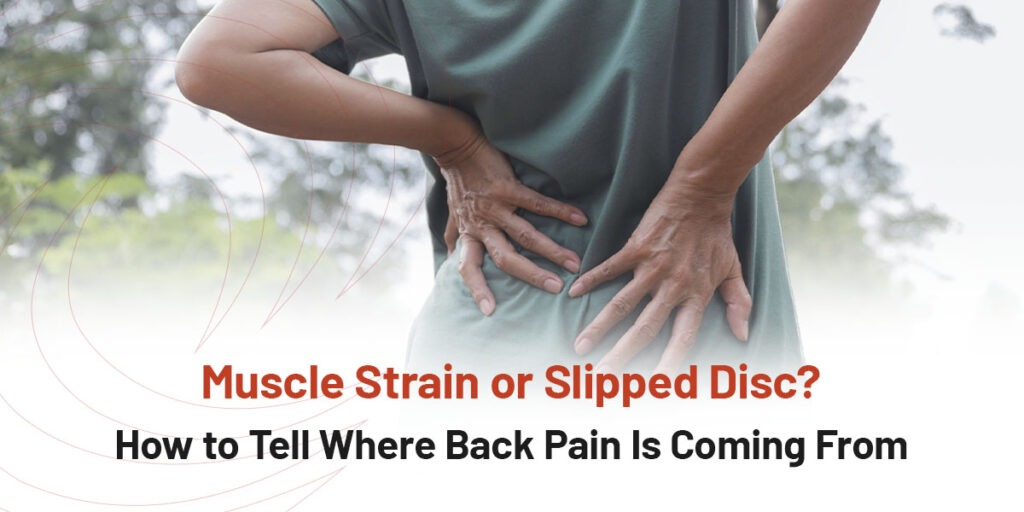
Back pain is the leading reason for workman’s compensation and lost work hours. In 2017, it was estimated that 7.5% of the global population experienced lower back pain. That might be a small number, but remember that it is around 577 million individuals. There are also tons of reasons why a person could experience back pain, such as inflammatory disorders, trauma, osteoporosis, nerve root compression, and degenerative disc disease. The list can keep going.
But how do you tell if back pain is a muscle or a disc issue? A pulled muscle can often heal itself or with very little intervention, but a slipped disc can cause a world of issues if not detected early.
In 2020, lower back pain affected 619 million people globally. But what exactly is it? The human spine is a complex structure composed of vertebrae, intervertebral discs that sit between the vertebrae bones and then a lot of interlinking nerves, muscles and ligaments.
The intervertebral discs act as shock absorbers for the spine. They have a tough outer layer known as the annulus fibrosis and then a soft gel-like center. The spine is the protective unit that houses all the nerves. It is basically like a cable protector between the brain and the rest of the body.
A slipped disc is when the soft inner part of the disc protrudes through a tear or weakness in the outer layer. There are a number of factors that can cause this, which we’ll discuss later. But what you need to know is that when this disc material protrudes, it puts pressure on the spinal nerves and causes discomfort and pain, among other symptoms.
Back pain is usually caused by a muscle being pulled or over-used. Slipped discs usually involve something sudden or general wear and tear. Let’s have a closer look at the former first:
Slipped discs have different types of causes than above:
Both conditions can cause general back pain, which might make it confusing for the individual to differentiate between them. The first thing that can help you is the nature of the pain. Signs of pulled back muscle are that the pain is usually dull and aching. You’ll find it feels like it is in the back and often gets work if you don’t rest that area.
With a slipped disc, the pain is much sharper. It can even feel like it’s radiating through the back, into the shoulders or surrounding areas. You might have experienced nerve-type damage as it pushes onto the spinal cord, like numbness or pins and needles.
Muscle strains are characterized by damage to the fibers or tendons. It will be a localized pain in the back immediately during the injury. There is no apparent visual sign that you have pulled a muscle. You might slowly see some swelling or inflammation. In some cases, even bruising. The biggest giveaway will be the sensation.
Getting a healthcare professional to physically examine and gently press on the affected area can help identify which muscle is strained. You can also try to move or stretch different areas to localize the issue.
A lower back muscle strain treatment can usually be done with home care. Place ice packs, wrapped in a towel, on the affected area for 10-20 minutes every four hours for the first day or two to help reduce the swelling. If the area is accessible, such as a superficial muscle group, consider using elastic compression in that area to reduce inflammation further.
Resting is the best thing you can do to help your back. Avoid doing sports or heavy lifting for a week or two. If you find the back pain gets worse or doesn’t go away, consult with a healthcare professional to see if there isn’t a more significant issue at play.
Slipped discs are a lot more focused than a strained muscle. The pain will likely be sharp and radiating, as opposed to a localized, aching pain of muscle. Because the disc puts pressure on the spinal cord, there will also be a neurological symptom, such as tingling or numbness. If you suspect a slipped disc, try not to move the area too much by stretching. Stretching and contracting can worsen the issue. Get to a healthcare professional for a physical examination. They will be able to assess the pain response and reflexes and either let you know if it is a false alarm or if you need further imaging tests.
The treatment of a slipped disc is not something you can do on your own or at home. It is best to consult a healthcare provider to determine the severity of the condition. They will recommend a mix of pain management with medication, physical therapy and lifestyle modifications. Spine surgery is only used in cases of severe conditions.
We focus on compassionate care and diagnostic techniques to find the very source of your back pain. From there, we can create a tailored treatment for you, knowing your condition and details. We always go with least invasive spine care options, including nonsurgical treatments, medication, therapeutic pain injections and exercises. If there is a larger issue and the symptoms increase, we can recommend surgical intervention.
The three common types of slipped discs are the protruded herniated disc, extruded herniated and sequestered herniation. We can treat all three and give you a personalized treatment plan that meets your exact needs. Schedule an appointment with us so we can get to know you and you can learn more about our ultra-minimally invasive techniques. Our goal is to get you back to enjoying life again.